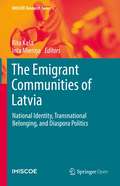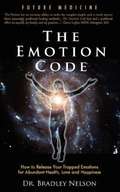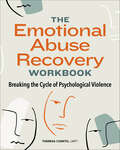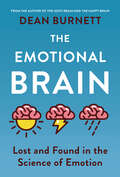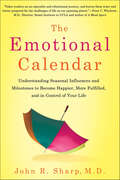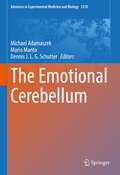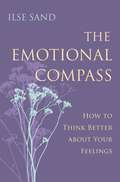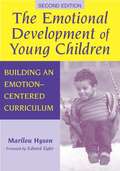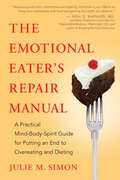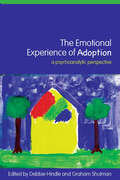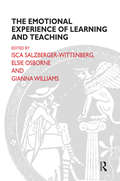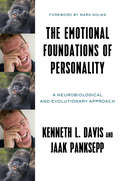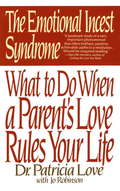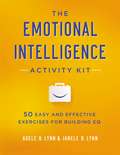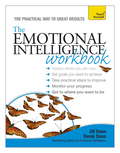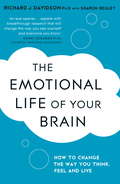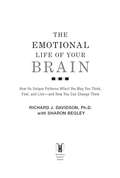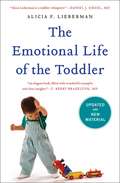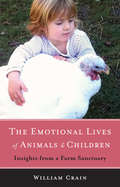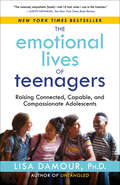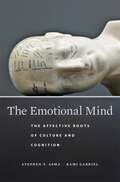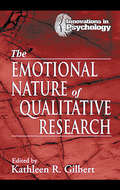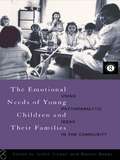- Table View
- List View
The Emigrant Communities of Latvia: National Identity, Transnational Belonging, and Diaspora Politics (IMISCOE Research Series)
by Rita Kaša Inta MieriņaThis open access volume examines experiences of contemporary Latvian migrants, thereby focusing on reasons for emigration, processes of integration in their host countries, and – in the case of return migration - re-integration in their home country. In the context of European migration, the book describes the case of Latvia, which is interesting due to the multiple waves of excessive emigration, continuously high migration potential among European Union member states, and diverse migrant characteristics. It provides a fascinating insight into the social and psychological aspects linked to migration in a comparative context. The data in this volume is rich in providing individual level perspectives of contemporary Latvian migrants by addressing issues such as emigrants’ economic, social and cultural inclusion in the host country, ties with the home country and culture, interaction with public authorities both in the host and home country, political views, and perspectives on the permanent settlement in migration or return. Through topics such as assimilation of children, relationships between emigrants representing different emigration waves, the complex identities and attachments of minority emigrants, and the role of culture and media in identity formation and presentation, this book addresses topics that any contemporary emigrant community is faced with.
The Emotion Code: How to Release Your Trapped Emotions for Abundant Health, Love and Happiness
by Bradley B. NelsonA renowned holistic physician and lecturer skillfully lays bare the inner workings of the subconscious mind to reveal how emotionally charged events from the past can become "trapped emotions"--emotional energies that literally inhabit one's body. Dr. Nelson explains clearly and concisely how trapped emotions can create pain, malfunction, and eventual disease--and ways of ridding oneself of that baggage.
The Emotional Abuse Recovery Workbook: Breaking the Cycle of Psychological Violence
by Theresa ComitoMove your life forward with this workbook for healingMove away from harmful personal and professional relationships, and instead, toward recovery and growth. This accessible workbook will help you identify and acknowledge abuse, validate your feelings, practice self-care, set boundaries, create a safety plan, examine healthy relationships, and design your exit plan.The Emotional Abuse Recovery Workbook offers ways to work through your trauma, leading you through the process of awareness, understanding, and healing. Engaging exercises steer you to look inward and examine and navigate relationships, while keeping your health and safety a priority. You'll identify your strengths and values, work out strategies to manage daily challenges, discover your resilience, and promote improved self-worth and a sense of well-being.In this workbook you'll learn to:Identify emotional abuse—Begin to recognize, acknowledge, and understand the dynamics of emotional abuse, and start your recovery process.Take action—Move into guided examinations of your relationships. Make an exit plan with boundaries and safety nets to build new, healthier skills, and rediscover self-compassion and self-care.Move forward—Avoid repeating old patterns. Rebuild. Map out next steps into healthier relationships and greater independence while you enhance your network of supporters.Regain your freedom and sense of self with The Emotional Abuse Recovery Workbook.
The Emotional Brain: Lost and Found in the Science of Emotion
by Dean BurnettHappy, sad, angry, glad—why do we cry when we’re ecstatic or mad? A fascinating look at the science of emotionEmotions can be a pain. After his father died of Covid, Dean Burnett found himself wondering what it would be like to live without emotion. And so, he decided to put his feelings under the microscope—for science.With his trademark humour, Burnett takes us on an incredible journey of discovery, stretching from the origins of life to the ends of the universe. Along the way, he reveals why we would ever follow our gut; whether things really were better in the old days; why it’s so hard to stop doomscrolling; how sad music can make us happier; why we can’t think straight when hungry; the point of nightmares; and why it is virtually impossible to forget embarrassing memories.
The Emotional Calendar: Understanding Seasonal Influences and Milestones to Become Happier, More Fulfilled, and in Control of Your Life
by John R. SharpA leading Harvard psychiatrist reveals how our emotional lives are profoundly shaped by the seasons, and how to recognize our own seasonal patterns and milestonesIn two decades of psychiatry practice, John R. Sharp has worked with many people who experienced the same emotional distresses at specific times of the year—a young woman who became depressed before Thanksgiving, a middle-aged man who felt anxious about making his summer travel plans, people who made uncharacteristically extreme decisions as spring approached.In The Emotional Calendar, Sharp reveals how environmental, psychological, and cultural forces profoundly affect the way we feel, and how the enduring effects of personal anniversaries can influence our moods and behavior year after year. Sharp also illustrates a wide range of individual responses to cultural phenomena: some people feel anxious at the start of a new school year or are undone by the prospect of tax season while others are buoyed by the start of a sports season.Sharp shows us how to recognize the milestones on our own emotional calendars, providing guidance for how to break stifling patterns and remedy destructive moods. This empathetic and deeply resonant book will help readers reach an emotional balance for the years ahead.
The Emotional Cerebellum (Advances in Experimental Medicine and Biology #1378)
by Mario Manto Michael Adamaszek Dennis J. L. G. SchutterEmotions represent a critical aspect of daily life in humans. Our understanding of the mechanisms of regulation of emotions has increased exponentially these last two decades. This book evaluates the contribution of the cerebellum to emotion. It outlines the current clinical, imaging and neurophysiological findings on the role of the cerebellum in key aspects of emotional processing and its influence on motor and cognitive function and social behavior.In the first section, the reader is introduced to the contributions of the cerebellum to various emotion domains, from emotion perception and recognition to transmission and encoding. Subsequent chapters provide a comprehensive picture of the neurophysiology and topography of emotion in the cerebellum and illustrate the convergence of theoretical and empirical research. Additional chapters address the cerebellum's involvement in emotional learning, emotional pain, emotional aspects of body language and perception, and its relations to social cognition including morality, music, and art. Finally, neuropsychiatric aspects of the cerebellum's influence on mood disorders and the current state of therapeutic options, including noninvasive stimulation approaches, complete the overview. This is the first book summarizing the current state of knowledge on the contribution of the cerebellum to important aspects of emotion. It is an essential reference for students, trainees, neuroscientists, researchers, and clinicians in neuroscience, neurology, neurosurgery and psychology involved in the study of emotions. The authors are renowned scientists in the field of cerebellar research.
The Emotional Compass: How to Think Better about Your Feelings
by Ilse Sand'Feelings are something we have, not something we are.' Revealing the complexity of emotions such as happiness, anger, fear, and jealousy, and how these are based on our perception of other people, Ilse Sand offers her professional wisdom on the psychology of feelings. Establishing that emotions are not always as appropriate as they first appear to be, the book encourages you to take a closer look at why you are feeling certain things, and how you can change how you feel. Especially written for highly sensitive people, guidance is included on how to identify the vulnerable feelings that often underlie our more volatile emotional states, and practical activities are suggested to help to embrace or reject sadness, delay impulsive actions, and allow yourself to be happy. Drawing on real-life examples throughout, the book offers you the means to improve your understanding of not only your own emotions and emotional actions, but those of others. The book will be immensely useful not only to people who feel things strongly, but to those who have trouble understanding or interpreting emotions and how to respond to the feelings they provoke.
The Emotional Development Of Young Children: Building An Emotion-centered Curriculum
by Marilou HysonMarylou Hyson provides educators with real-life examples and evidence-based teaching strategies to advance children's understanding and appropriate expression of their emotions.
The Emotional Eater's Repair Manual: A Practical Mind-Body-Spirit Guide for Putting an End to Overeating and Dieting
by Julie M. SimonDespite our best intentions, many of us find ourselves routinely overeating at meals, snacking mindlessly, or bingeing regularly. As emotional eaters, we turn to food for comfort, soothing, distraction, and excitement. There’s a disconnection fueling our eating, robbing years from our lives, and we know it. We’re tired of restrictive diets that lead back to overeating, and we’re ready to try something different. Therapist and life coach Julie Simon offers a new approach that addresses the true causes of overeating and weight gain: emotional and spiritual hunger and body imbalance. The Emotional Eater’s Repair Manual presents five self-care skills, five body-balancing principles, and five soul-care practices that can end overeating and dieting forever. You’ll learn to nurture yourself without turning to food, to correct body and brain imbalances that trigger overeating, and to address your soul’s hunger. Weight loss, more energy, improved health, and self-esteem will naturally follow.
The Emotional Experience of Adoption: A Psychoanalytic Perspective
by Debbie Hindle Graham ShulmanAdoption is an extremely complex and emotionally demanding process for all those involved. This book explores the emotional experience of adoption from a psychoanalytic perspective, and demonstrates how psychoanalytic understanding and treatment can contribute to thinking about and working with adopted children and their families. Drawing on psychoanalytic, attachment and child development theory, and detailed in-depth clinical case discussion, The Emotional Experience of Adoption explores issues such as: the emotional experience of children placed for adoption, and how this both shapes and is shaped by unconscious processes in the child’s inner world how psychoanalytic child psychotherapy can help as a distinctive source of understanding and as a treatment for children who are either in the process of being adopted or already adopted how such understanding can inform planning and decision making amongst professionals and carers. The Emotional Experience of Adoption explains and accounts for the emotional and psychological complexities involved for child, parents and professionals in adoption. It will be of interest and relevance to anyone involved at a personal level in the adoption process or professionals working in the fields of adoption, social work, child mental health, foster care and family support.
The Emotional Experience of Learning and Teaching
by Margot Waddell Gianna Williams Isca Salzberger-Wittenberg Elsie OsborneThis book aims to heighten the awareness of the emotional factors which enter into the process of learning and teaching. It is based on the work done by the authors with a group of teachers who attended the Tavistock Clinic for a course called Aspects of Counselling in education.
The Emotional Foundations of Personality: A Neurobiological And Evolutionary Approach
by Jaak Panksepp Mark Solms Kenneth L. DavisA novel approach to understanding personality, based on evidence that we share more than we realize with other mammals. This book presents the wealth of scientific evidence that our personality emerges from evolved primary emotions shared by all mammals. Yes, your dog feels love—and many other things too. These subcortically generated emotions bias our actions, alter our perceptions, guide our learning, provide the basis for our thoughts and memories, and become regulated over the course of our lives. Understanding personality development from the perspective of mammals is a groundbreaking approach, and one that sheds new light on the ways in which we as humans respond to life events, both good and bad. Jaak Panksepp, famous for discovering laughter in rats and for creating the field of affective neuroscience, died in April 2017. This book forms part of his lasting legacy and impact on a wide range of scientific and humanistic disciplines. It will be essential reading for anyone trying to understand how we act in the world, and the world’s impact on us.
The Emotional Incest Syndrome: What to Do When a Parent's Love Rules Your Life
by Patricia Love Jo RobinsonFrom Dr. Patricia Love, a ground-breaking work that identifies, explores and treats the harmful effects that emotionally and psychologically invasive parents have on their children, and provides a program for overcoming the chronic problems that can result.
The Emotional Intelligence Activity Kit: 50 Easy and Effective Exercises for Building EQ
by Adele Lynn Janele LynnElevate emotional intelligence throughout your organization—and watch profitability, retention, and customer satisfaction soar!Know-it-all bosses, overcompetitive colleagues, and leaders who rarely leave their offices--common EQ problems such as these damage not just camaraderie, but also results. Because of this, managers are discovering now more than ever that emotional intelligence (EI)--knowing how to manage emotions, empathize, build relationships, and more--is a vital contributor to a company&’s success. But how does one go about persuading others to improve their EI?The Emotional Intelligence Activity Kit shows the way with 50 practical exercises to:Promote introspectionIncrease empathyImprove social skillsBoost influenceInspire purposeBring everyone on boardStudies have proven that emotional intelligence drives performance. But the problem has always been how to utilize this knowledge and inspire new ways of thinking among individuals.With The Emotional Intelligence Activity Kit, trainers, coaches, and organizational development professionals can now break through and trigger lasting EQ improvements to create thriving, successful organizations.
The Emotional Intelligence Workbook: Teach Yourself
by Jill Dann Derek DannDo you want to be able to persuade, influence, or empathise with people in any situation? Do you want to be able to click with people instantly? Do you want people to trust you? This new Teach Yourself Workbook doesn't just tell you what emotional intelligence is. It accompanies you every step of the way, with diagnostic tools, goal-setting charts, practical exercises, and many more features ideal for people who want a more active style of learning. The book starts by helping you identify the behaviours associated with emotional intelligence, and whether you are currently doing them. It then helps you set specific goals to improve on; as you progress through the book, you will be able to keep checking your progress against these goals. Specially created exercises, using the tools of NLP, hypnotherapy and cognitive psychology, will help you to boost your emotional intelligence so that you can reach your potential in any situation.
The Emotional Intelligence Workbook: Teach Yourself
by Jill Dann Derek DannDo you want to be able to persuade, influence, or empathise with people in any situation? Do you want to be able to click with people instantly? Do you want people to trust you?This new Teach Yourself Workbook doesn't just tell you what emotional intelligence is. It accompanies you every step of the way, with diagnostic tools, goal-setting charts, practical exercises, and many more features ideal for people who want a more active style of learning. The book starts by helping you identify the behaviours associated with emotional intelligence, and whether you are currently doing them. It then helps you set specific goals to improve on; as you progress through the book, you will be able to keep checking your progress against these goals. Specially created exercises, using the tools of NLP, hypnotherapy and cognitive psychology, will help you to boost your emotional intelligence so that you can reach your potential in any situation.
The Emotional Life of Your Brain: How Its Unique Patterns Affect the Way You Think, Feel, and Live - and How You Can Change Them
by Sharon Begley Richard DavidsonThis groundbreaking book by a pioneer in neuroscience brings a new understanding of our emotions - why each of us responds so differently to the same life events and what we can do to change and improve our emotional lives.If you believe most self-help books, you would probably assume that we are all affected in the same way by events like grief or falling in love or being jilted and that only one process can help us handle them successfully.From thirty years of studying brain chemistry, Davidson shows just why and how we are all so different. Just as we all have our own DNA, so we each have our own emotional 'style' depending on our individual levels of dimensions like resilience, attention and self-awareness. Helping us to recognise our own emotional style, Davidson also shows how our brain patterns can change over our lives - and, through his fascinating experiments, what we can do to improve our emotional responses through, for example, meditation.Deepening our understanding of the mind-body connection - as well as conditions like autism and depression - Davidson stretches beyond mainstream psychology and neuroscience and expands our view of what it means to be human.
The Emotional Life of Your Brain: How Its Unique Patterns Affect the Way You Think, Feel, and Live--and How You Ca n Change Them (Playaway Adult Nonfiction Ser.)
by Richard J. DavidsonWhat is your emotional fingerprint? Why are some people so quick to recover from setbacks? Why are some so attuned to others that they seem psychic? Why are some people always up and others always down? In his thirty-year quest to answer these questions, pioneering neuroscientist Richard J. Davidson discovered that each of us has an Emotional Style, composed of Resilience, Outlook, Social Intuition, Self-Awareness, Sensitivity to Context, and Attention. Where we fall on these six continuums determines our own “emotional fingerprint. ” Sharing Dr. Davidson’s fascinating case histories and experiments, The Emotional Life of Your Brain offers a new model for treating conditions like autism and depression as it empowers us all to better understand ourselves—and live more meaningful lives. .
The Emotional Life of the Toddler
by Alicia F. LiebermanNow updated with new material throughout, Alicia F. Lieberman’s The Emotional Life of the Toddler is the seminal, detailed look into the varied and intense emotional life of children aged one to three. Hailed as “groundbreaking” by The Boston Globe after its initial publication, the new edition includes the latest research on this crucial stage of development.Anyone who has followed an active toddler around for a day knows that a child of this age is a whirlwind of explosive, contradictory, and ever-changing emotions. Alicia F. Lieberman offers an in-depth examination of toddlers’ emotional development, and illuminates how to optimize this crucial stage so that toddlers can develop into emotionally healthy children and adults. Drawing on her lifelong research, Dr. Lieberman addresses commonly asked questions and issues. Why, for example, is “no” often the favorite response of the toddler? How should parents deal with the anger they might feel when their toddler is being aggressively stubborn? Why does a crying toddler run to his mother for a hug only to push himself vigorously away as soon as she begins to embrace him? This updated edition also addresses twenty-first century concerns such as how to handle screen time on devices and parenting in a post-internet world. With the help of numerous examples and vivid cases, Lieberman answers these and other questions, providing, in the process, a rich, insightful profile of the roller coaster emotional world of the toddler.
The Emotional Lives of Animals and Children
by William CrainIn 2008, Bill Crain, a professor of psychology at The City College of New York, and his wife Ellen, a pediatrician, opened Safe Haven Farm Sanctuary in Poughquag, New York. The sanctuary provides a permanent home to over 70 animals rescued from slaughter and abusive situations, including goats, sheep, chickens, turkeys, ducks, partridges, and a mini-horse. It also has afforded Bill a tremendous opportunity to observe animals in all manner of emotional states and how their behavior casts light on the emotions of human children. In The Emotional Lives of Animals and Children, Crain honors the work of John Bowlby a psychoanalyst who began his major writings in the 1950s. Bowlby drew on biologists' observations of animals to provide a compelling account of children's attachment to their caretakers. "Today, the study of attachment is extremely popular," Crain writes, but "one would hardly know that the initial inspiration came from observations of non-human animals. Moreover, there has been little effort to extend Bowlby's work - to see how the study of animals illuminates other aspects of child development. " Crain suggests that the reluctance to follow Bowlby's lead reflects the Western worldview that considers humans as different from and superior to other species. To think about children in the same category as animals seems to demean children. But Crain discovered that the farm animals' emotional behaviors can help us understand those of human children. The Emotional Lives of Animals and Children is divided into two parts. Part one discusses six emotional behaviors that are shared by animals and children: fear, play, freedom, care, spirituality, and resilience. Part two addresses the broader social theme of our Western culture's disparagement of animals. Initially, children do not set themselves apart from nature, but experience it with an instinctive empathy. However, they are eventually taught by our society to detach themselves and to devalue animals. Crain writes, "As people attempt to move beyond society's dominant views of animals, they can also draw on a neglected idea that goes back to ancient times. This is the view that there is a special wisdom in the child's ways of knowing. This view is found in the ancient Chinese Taoist statement, 'wise souls are children. '" About Safe Haven Farm Sanctuary Safe Haven Farm Sanctuary is located in Poughquag, New York, about an hour and a half outside of New York City. Its focus is on the rescue of abused and neglected farm animals. In doing so, it hopes to raise awareness of the plight of animals raised for food and the benefits of a vegan diet for animals, human health, and the environment. Wherever possible, the sanctuary tries to implement environmentally sound practices such as solar heating and the use of reclaimed wood.
The Emotional Lives of Teenagers: Raising Connected, Capable, and Compassionate Adolescents
by Lisa Damour Ph.D.NEW YORK TIMES BESTSELLER • An urgently needed guide to help parents understand their teenagers&’ intense and often fraught emotional lives—and how to support teens through this critical developmental stage—from the author of Untangled and Under PressureDr. Lisa Damour worked as an expert collaborator on Pixar&’s Inside Out 2!&“How are we supposed to get our kids through these daunting years? There are countless books on the subject, but The Emotional Lives of Teenagers is the nuanced, empathetic one I wish I&’d had when I was in the trenches.&”—Judith Newman, The New York Times Book ReviewIn teenagers, powerful emotions come with the territory. And as teens contend with with academic pressure, social media stress, worries about the future, and concerns about their own mental health, it&’s easy for them—and their parents—to feel anxious and overwhelmed. But it doesn&’t have to be that way.Parents who read this book will learn:• what to expect in the normal course of adolescent emotional development and when it&’s time to worry• why teens (and adults) need to understand that mental health isn&’t about &“feeling good&” but about having feelings that fit the moment, even if those feelings are unwanted or painful• strategies for supporting teens who feel at the mercy of their emotions, so they can become psychologically aware and skilled at managing their feelings• how to approach common challenges that come with adolescence, such as friction at home, spiking anxiety, risky behavior, navigating friendships and romances, the pull of social media, and many more• the best ways to stay connected to their teens and how to provide the kind of relationship that adolescents need and wantWith clear, research-informed explanations alongside illuminating, real-life examples, The Emotional Lives of Teenagers gives parents the concrete, practical information they need to steady their teens through the bumpy yet transformational journey into adulthood.
The Emotional Mind: The Affective Roots of Culture and Cognition
by Stephen T. AsmaFor 200 million years before humans developed a capacity to reason, the emotional centers of the brain were hard at work. Stephen Asma and Rami Gabriel help us understand the evolution of the mind by exploring this more primal capability that we share with other animals: the power to feel, which is the root of so much that makes us uniquely human.
The Emotional Nature of Qualitative Research
by Kathleen R. GilbertThis book focuses on the place sand purpose of emotions in the research process, and explores the appropriate boundaries. Designed to explore how to manage the emotional content of research, the text service as a supplemental to qualitative research method courses, and is an excellent reference for the professional as well.
The Emotional Needs of Young Children and Their Families: Using Psychoanalytic Ideas in the Community
by Judith Trowell Marion BowerThe aim of this book is to provide illustrations of ways in which psychoanalytic ideas can be adapted and used in a wide variety of community settings - including social services, schools and hospitals - to help children and families who are emotionally disturbed or who have been physically or sexually abused. It is a book for professionals who are interested in using psychoanalytic ideas in their own work settings, and assumes no previous knowledge of these ideas on the part of the reader. It provides basic principles, many practical examples, further reading, and information about where to get support and consultation.
The Emotional Politics of Racism: How Feelings Trump Facts in an Era of Colorblindness
by Paula IoanideWith stop-and-frisk laws, new immigration policies, and cuts to social welfare programs, majorities in the United States have increasingly supported intensified forms of punishment and marginalization against black, Latino, Arab and Muslim people in the United States, even as a majority of citizens claim to support "colorblindness" and racial equality. With this book, Paula Ioanide examines how emotion has prominently figured into these contemporary expressions of racial discrimination and violence. How U. S. publics dominantly feel about crime, terrorism, welfare, and immigration often seems to trump whatever facts and evidence say about these politicized matters. Though four case studies--the police brutality case of Abner Louima; the exposure of torture at Abu Ghraib; the demolition of New Orleans public housing units following Hurricane Katrina; and a proposed municipal ordinance to deny housing to undocumented immigrants in Escondido, CA--Ioanide shows how racial fears are perpetuated, and how these widespread fears have played a central role in justifying the expansion of our military and prison system and the ongoing divestment from social welfare. But Ioanide also argues that within each of these cases there is opportunity for new mobilizations, for ethical witnessing: we must also popularize desires for justice and increase people's receptivity to the testimonies of the oppressed by reorganizing embodied and unconscious structures of feeling.
